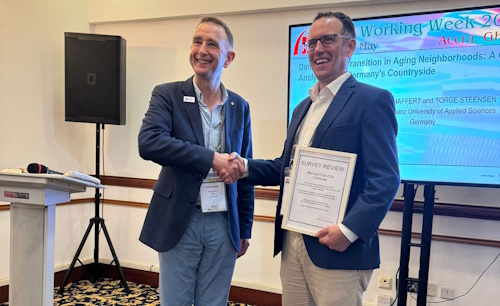Article of the Month -
August 2024
|

Demographic transition in aging
neighborhoods: a GIS-based analysis from Germany's countryside
Markus Schaffert and Torger Steensen,
Germany
This article was awarded the Survey Review Prize and
was presented during the FIG Working Week 2024 in Accra, Ghana.
FIG and Survey Review have
decided to award a paper presented at a
FIG Congress/Working Week. The Survey Review prize will be awarded
every two years to the author and presenter of a selected paper at a
FIG Congress/Working Week and will be limited to submissions from
authors who fulfil the FIG definition of a Young Surveyor.
Survey Review is an international journal which has been published
since 1931, and in recent years under the auspices of the Commonwealth
Association of Surveying and Land Economy (CASLE). It has been published
continuously as a quarterly journal, bringing together a wide range of
papers on research, theory, practice and management in land and
engineering surveying.
The paper selected for the prize passes through an initial reviewing
and revision stage overseen by FIG, before being judged by members of
the Editorial Board of Survey Review.
This year’s winner, “Demographic transition in aging neighborhoods: a
GIS-based analysis from Germany's countryside ” by Markus Schaffert and
Torger Steensen, Germany

SUMMARY
The ongoing demographic transition within aging
single-family house neighborhoods in Germany poses a
significant challenge for municipalities. The scarcity of
data and information related to demographic composition and
location quality complicates research efforts and the
development of adaptive strategies for these residential
areas. This issue is particularly pronounced in rural
regions where resources for capturing and analyzing
demographic trends are limited. To address this gap, we
propose a methodology based on geographic information
systems. In this approach, municipal population registers
serve as a central data source for extracting insights about
the residents. We present the findings primarily in the form
of maps, as they are intended to be easily comprehensible
for urban planners and local government staff. Additionally,
we outline the initial steps in establishing a small-scale
monitoring system that incorporates demographic indicators
as well as reachability estimates. A case study from
northern Bavaria is used as an illustration.
The full paper is available to read
here.
























